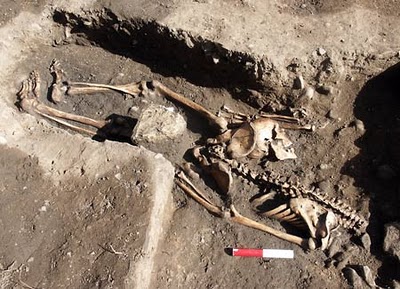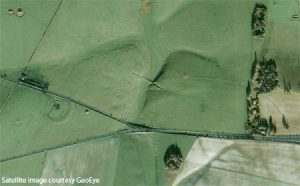 The biblical narrative of the crossing of the Red Sea has inspired and mystified people for millennia. So far, Archeologists and Egyptologists have found little direct evidence to substantiate many of the events described in Exodus, said to have taken place more than 3,000 years ago.
The biblical narrative of the crossing of the Red Sea has inspired and mystified people for millennia. So far, Archeologists and Egyptologists have found little direct evidence to substantiate many of the events described in Exodus, said to have taken place more than 3,000 years ago.
Now, a new study offers a new hydrodynamic explanation for the miracle a strong east wind, blowing overnight, could have created a land bridge (watch the video) and allowed for passage.
By pinpointing a possible site south of the Mediterranean Sea for the crossing, the study – based on a reconstruction of the likely locations and depths of Nile delta waterways, which have shifted considerably over time – could benefit experts seeking to research whether splitting of the Red Sea ever took place.
The computer model shows the winds pushing the water back at a bend where an ancient river is believed to have merged with a coastal lagoon – named the ‘Lake of Tanis’ by Herodotus – along the Mediterranean Sea. With the water pushed back into both waterways, a land bridge would have opened at the bend, enabling people to walk across exposed mud flats to safety. As soon as the wind died down, the waters would have rushed back in.
“The simulations match fairly closely with the account in Exodus,” says Carl Drews of the National Center for Atmospheric Research. “The parting of the waters can be understood through fluid dynamics. The wind moves the water in a way that’s in accordance with physical laws, creating a safe passage with water on two sides and then abruptly allowing the water to rush back in.”

The computer simulations by Carl Drews and University of Colorado at Boulder (CU) oceanographer Weiqing Han are intended to present a possible scenario of events.
The book of Exocus describes Moses and the fleeing Israelites trapped between the Pharaoh’s advancing chariots and a body of water that has been variously translated as the Red Sea or the Sea of Reeds. Although the biblical account attributes the splitting of the waters to the Lord’s power, it includes an east wind as natural component in the chain of events.
Then Moses stretched out his hand over the sea, and the Lord drove the sea back by a strong east wind all night and made the sea dry land, and the waters were divided. And the people of Israel went into the midst of the sea on dry ground, the waters being a wall to them on their right hand and on their left.

This enables the Israelites to flee to the other shore. When when the Pharaoh’s army attempts to pursue them in the morning, the waters rush back and drown the soldiers.
Reconstructing ancient topography
Studying maps of the ancient topography of the Nile delta, the researchers found an alternative site for the crossing about 75 miles north of the Suez reef and just south of the Mediterranean Sea.
Although there are uncertainties about the waterways of the time, some oceanographers believe that an ancient branch of the Nile River flowed into a coastal lagoon then known as the Lake of Tanis.
The two waterways would have come together to form a U-shaped curve.
Analysis of archeological records, satellite measurements, and current-day maps enabled the research team to estimate the water flow and depth that may have existed 3,000 years ago.
Using an ocean computer model to simulate the impact of an overnight wind at that site, the researchers found that a wind of 63 miles an hour, lasting for 12 hours, would have pushed back waters estimated to be six feet deep. This would have exposed mud flats for four hours, creating a dry passage about 2 to 2.5 miles long and 3 miles wide. The water would be pushed back into both the lake and the channel of the river, creating barriers of water on both sides of newly exposed mud flats.
As soon as the winds stopped, the waters would come rushing back, much like a tidal bore. Anyone still on the mud flats would be at risk of drowning.
Video: The Physics of a Land Bridge
Sustained winds can cause an event known as a wind setdown, in which water levels are temporarily lowered. This computer animation (by Tim Scheitlin and Ryan McVeigh, NCAR) shows how a strong east wind over the Nile Delta could have pushed water back into ancient waterways after blowing for about nine hours, exposing mud flats and possibly providing an overland escape route similar to the biblical account of the Red Sea parting.
The set of 14 computer model simulations also showed that dry land could have been exposed in two nearby sites during a windstorm from the east.
However, those sites contained only a single body of water and the wind would have pushed the water to one side rather than creating a dry passage through two areas of water.
“People have always been fascinated by this Exodus story, wondering if it comes from historical facts,” Drews says. “What this study shows is that the description of the waters parting indeed has a basis in physical laws.”
Alternative Theories for the Red Sea Escape Route
Scientists from time to time have tried to study whether the parting of the waters, can also be understood through natural processes.
Tsunami
Some have speculated about a tsunami, which would have caused waters to retreat and advance rapidly. Such an event would not have caused the gradual overnight divide of the waters as described in the Bible, nor would it necessarily have been associated with winds.
Wind Setdown & Underwater Reef
Other researchers have focused on a phenomenon known as “wind setdown,” in which a particularly strong and persistent wind can lower water levels in one area while piling up water downwind. Wind setdowns, which are the opposite of storm surges, have been widely documented, including an event in the Nile delta in the 19th century when a powerful wind pushed away about five feet of water and exposed dry land.
A previous computer modeling study into the Red Sea crossing by a pair of Russian researchers, Naum Voltzinger and Alexei Androsov, found that winds blowing from the northwest at minimal hurricane force (74 miles per hour) could, in theory, have exposed an underwater reef near the modern-day Suez Canal. This would have enabled people to walk across.
But according to Drews and Han, the ‘reef scenario’ is unlikely. The reef would have had to be entirely flat for the water to drain off in 12 hours. A more realistic reef with lower and deeper sections would have retained channels that would have been difficult to wade through. In addition, the scientists are skeptical if refugees could have crossed during nearly hurricane-force winds.
The study (published in the online journal PLoS ONE as ‘Dynamics of Wind Setdown at Suez and the Eastern Nile Delta‘) is part of a larger research project by Drews into the impacts of winds on water depths, including the extent to which Pacific Ocean typhoons can drive storm surges.



